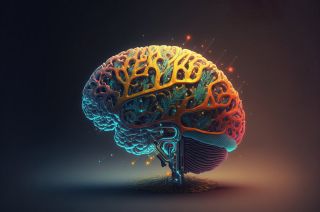Artificial Intelligence
How Reliable is fMRI for Mental Health Research?
Using machine learning and neuroimaging to predict mental states and disorders.
Posted March 31, 2023 Reviewed by Tyler Woods

Neuroscientists are using artificial intelligence (AI) machine learning to identify potential predictive biomarkers by finding patterns in the noisy, complex data of brain images. Can AI algorithms using functional magnetic resonance imaging (fMRI) data be used as a diagnostic tool to effectively predict individual traits and mental health disorders? Dartmouth and Essen University Hospital researchers recommend a new approach for using AI to find neuromarkers in brain imaging data and published their analysis in the journal Nature this month.
“We argue that the field should focus on discovering phenotypes and brain measures with large effect sizes,” wrote lead author Tamás Spisák, Ph.D., the head of the Predictive Neuroimaging Lab at the Institute of Diagnostic and Interventional Radiology and Neuroradiology at Essen University Hospital, along with Tor Wager, Ph.D., the Diana L. Taylor, Distinguished Professor in Neuroscience at Dartmouth College, and Ulrike Bingel, M.D., Ph.D., and the director of the Interdisciplinary Center for Pain Medicine and Translational Pain Research in the department of neurology at Essen University Hospital.
Magnetic resonance imaging
“Brain-wide association studies (BWAS)—which correlate individual differences in phenotypic traits with measures of brain structure and function—have become a dominant method for linking mind and brain over the past 30 years,” wrote the researchers. Magnetic resonance imaging is a non-invasive medical imaging method that combines computer-generated radio waves with a magnetic field in order to produce clear, three-dimensional (3D) images of the body’s tissues and organs. Unlike computed tomography (CT), magnetic resonance imaging does not use the damaging, ionizing radiation of X-rays. Instead, a temporary magnetic field is created using an electric current via coiled wires while radio signals are transmitted and received in the scanner which a computer converts to digital images.
The most frequently imaged nucleus for clinical MRIs is hydrogen, a main component of water that is commonly found in tissues and organs. The spin of the hydrogen proton in the central nucleus acts like a magnet, and their axes realign when exposed to the stronger magnetic field of the MRI scanner.
In particle physics, resonance is the phenomenon when an object vibrating at the same natural frequency of another object causes the other object to vibrate. At the center of an atom is the positively charged nucleus, consisting of protons with positive charges and neutrons with no charge. If radio waves are directed at the nuclei of atoms, they selectively absorbs the energy via resonance.
Neuroscience and fMRI
Functional magnetic resonance imaging, or functional MRI, uses MRI technology to measure brain activity by detecting the blood oxygen level-dependent (BOLD) contrast. Specifically, fMRI detect the magnetic signals of hemoglobin molecules as blood oxygen levels change. Researchers correlate this to the firing of neurons. Since the introduction of fMRI in 1991 by John (Jack) Belliveau, Ph.D., and Kenneth Kin Man Kwong, Ph.D., fMRI has become an important tool in neuroscience.
How Much Data is Needed for Brain-Wide Association Studies?
A recent study conducted by Scott Marek, Ph.D., at the Washington University School of Medicine in St. Louis, Brenden Tervo-Clemmens, Ph.D., at Massachusetts General Hospital/Harvard Medical School, and their research colleagues, suggest that the reproducibility of brain-wide association studies require samples from thousands of individuals.
“Mental health research and care have yet to realize similar advances from MRI,” wrote Marek and his colleagues. “A primary challenge has been replicating associations between inter-individual differences in brain structure or function and complex cognitive or mental health phenotypes (brain-wide association studies (BWAS)).”
In their analysis of roughly 50,000 individuals using three of the largest available neuroimaging datasets, Marek and his co-authors found that replication rates improved, and effect size inflation decreased as sample sizes increased into the thousands.
Spisák and co-authors agree with Marek’s study that large samples are required for conducting the analysis of one variable (univariate) brain-wide association studies and that multivariate BWAS reveal much larger effects, and are thus more highly powered.
However, the Dartmouth and Essen University Hospital researchers say that Marek’s study findings apply to specific cases, and that fMRI data from hundreds of individuals, versus thousands, can be successfully leveraged. The key is to harness the pattern-recognition capabilities of AI machine learning algorithms. In their analysis, they show that multivariate brain-wide association studies effects in high quality datasets can be replicable with substantially smaller sample sizes.
“Our results highlight that the key determinant of sample size requirements is the true effect size of the brain–phenotype relationship, which subsumes the amount, quality, homogeneity and reliability of both brain and phenotypic measures, and the degree to which a particular brain measure is relevant to a particular phenotype,” they wrote.
Copyright © 2023 Cami Rosso All rights reserved.




